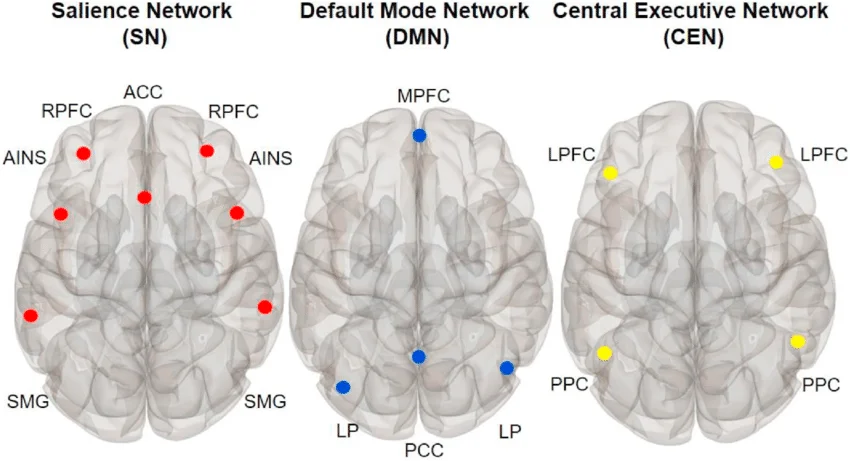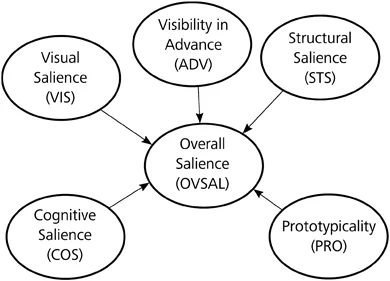
Do you know that your brain’s salience network is essential for filtering and prioritizing information, influencing how we respond to salient stimuli in our environment and impacting our executive function? is crucial for understanding how our brain processes salient information in both neural and cognitive contexts, particularly through brain mapping techniques? is working wonders when you are going on a road and then you see a hoarding of a smartphone that grabs your attention? The attention-grabbing part is performed by our brain salience network, which decides which external stimuli need attention and focus, thus enhancing our salience processing capabilities through intrinsic connectivity.
The cognitive processes, emotional regulation, and decision-making are all done by the brain salience network, which interacts closely with the brain’s default network. But what is the salience network actually, and how does it interact with other functional networks in the brain?
This post will shed light on this miracle network and why it matters to humans. If its functioning is impaired, will our lives be changed due to the lack of functional connectivity in the salience network?
Role in Cognitive Functions
The salience network The brain has the ability to move between the default mode network (DMN) and the central executive network (CEN), demonstrating the flexibility of salience network connectivity. It is important to understand all of the networks so that all of the collaboration can be interpreted which is mandatory for the perfect functioning of the human brain.
SN can move between DMN and CEN

DMN
According to a study published in 2014, which was based on the foundations of a 2007 study, it is known that DMN is the part of the brain that is active in a resting state and in those tasks that do not need attention.
DMN comprises the posterior cingulate, posterior parietal cortex, and the ventromedial prefrontal cortex, which are important for the brain’s large-scale networks and intrinsic connectivity networks.
CEN
Based on the same research, CEN is involved in those tasks that require high cognitive activity and need attention for the task, reflecting the brain state during such activities.
CEN comprises the dorsolateral prefrontal cortex and posterior parietal cortex, both of which are integral nodes in the brain’s functional connectivity and overall network of the human brain.
Salience network (SN)
The salience brain regions are responsible for cognitive, homeostatic, or emotional regulation of the brain that helps humans respond to external stimuli accordingly, emphasizing their role as critical nodes in the salience network.
Salience brain regions involve the anterior insular cortex (ACC), anterior insula, and ventrolateral prefrontal cortex (VLPFC), all of which play critical roles in functional networks related to emotional processing.
It might be complicated for the common man to understand these terms related to the network of the human brain. But it could be generally understood that the salience network prioritizes sensory and emotional information, playing a key role in brain areas involved in decision-making. Therefore, it is commonly inferred that people who have depression have more active salience brain regions than normal people, affecting their working memory and emotional regulation. It is even apparent in people with fewer symptoms of depression that brain connectivity plays a significant role in emotional health.
Depression patients tend to be selective with a sustained focus on certain things, which usually are negative and therefore cause negative impacts on their long-term brain functioning. Their divided attention causes problems in their emotional regulation, which is directly related to the brain function of the salience network and its interaction with the default-mode network.
NOTE: The salience network is divided into two subsystems: one is the dorsal salience network which is associated with the processing of sensory information. The attention is also directed to other self-generated stimuli or external ones, highlighting the role of the insular cortex in processing these inputs.
Another is the ventral salience network which is associated with the processing of the emotional side of stimuli.
Emotional and social processing
This section will elaborate on the functioning of the salience network in the brain in a way that is more easily interpreted by the common man.
The salience network in brain has a deep interaction with emotional regulation systems. The parts of the salience network (SN) called insula and cingulate are accountable for selecting those stimuli that are worth our time and should be selected for investing our time of attention towards them.
View this post on Instagram
These stimuli and the related attention of our brain would regulate our moods and influence brain connectivity. For example, stimuli where a kid is misbehaving with the mother would regulate her emotions toward anger, impacting her internal and external stimuli responses. In another instance, a husband showing love to her wife would regulate her mood towards happiness and satisfaction, illustrating the impact of brain areas involved in emotional processing.
Moreover, the brain function in the salience network is more active when it needs to direct its thoughts over empathy, social cognition, and emotional awareness, showcasing the importance of brain mapping in understanding these processes. Research proved that increasing empathic concerns are related to hyperconnectivity in cognitively healthy older adults and their salience network, underlining the significance of functional connectivity in neuroscience.
It means that greater emotional regulation was observed in older participants with MCI (mild cognitive impairment) and AD (Alzheimer’s disease) but cognitively healthy individuals. Since emotional contagion is a self-regulated form of emotional empathy, it could be related to distress and the functioning of the salience network within our brain’s network dynamics.
The reason for such a connection with distress is the self-oriented feelings of compassion when a person hears something sad about another person and feels the same for him. It could be due to the self-believed benefits or drawbacks in the same situation, which are often assessed through the lens of brain structure and its connectivity within functional brain networks, highlighting the importance of neural correlates. People become more sensitive to those affective cues and self-perceive the effects that might have been on their own if they were facing a similar scenario, leading to high empathy and high cognitive use of the salience network, where attention to detail matters.
Brain salience network and mental health
An impairment in the salience network is associated with affective deficits, which can disrupt large-scale brain networks. It suggests that it could result in diseases like schizophrenia, autism, and bipolar disorder, which may be linked to aberrant salience processing and neural disruptions.
Schizophrenia
Take one example at a time. Research suggests that schizophrenia is characterized by impaired thinking and selection of external stimuli, leading to disruptions in the functional human brain networks involved in perception. There occurs a defect in executive control over thoughts, hence a malfunction in DMN.
Autism
A similar situation occurs in people suffering from autism. Autism is generally a disorder where a person finds a problem in social interactions and the associated behavioral patterns. If a deficit in communication between sensory and limbic structures is present, leading to the salience network, then there exists an “underestimation” of the external stimuli and a potential disruption in network activity. The importance of social stimuli is neglected by the impaired salience network, implying a dysfunctional behavioral pattern, resulting in autism.
Bipolar disorder
In people suffering from bipolar disorder, it was noted that the connectivity patterns were changed that were dependent on mood, reflecting the influence of the triple network model. With this altered connectivity seen with the salience network and frontoparietal network (FPN), the problems of bipolar disorder remain. The lack of integration between FPN and the salience network is quite evident in such patients, suggesting a disruption in their structural and functional connectivity.
Implications for decision-making
The salience brain regions are associated with the interoception of feelings of risks and rewards, emphasizing their role in processing salient stimuli. That is why they think deeply about the information from internal and external sensations that are based on the risks and rewards of a situation, highlighting the importance of neural salience processing.
For example, a child is thinking about studying hard to get good grades in an exam, he would think of other consequences, which are minute details of his detailed thinking, such as parents and teachers being happy, getting an achievement reward from school or parents, or even getting an XBOX that his father had promised if he got 90 percent.
He needs to engage in the decision-making process and needs to analyze the risks on the other side, considering the implications on brain connectivity and the neural correlates involved. The details of risk might involve getting grounded for days, getting scolded by a teacher, or losing the opportunity to win the XBOX.
Hence, the salience network looks upon the details actively, either risk or reward, helping for appropriate decision-making by integrating information from subcortical structures and enhancing network activity.
In 2008, researchers suggested three forms of salience processing: visual salience, structural salience, and cognitive salience. Visual salience asks for the size, color, and shape of the objects that our brain wants to focus on. Structural salience is the position of the objects or stimulus in the environment, impacting how we perceive salient features. Cognitive salience is the personal significance of the stimulus for an individual, particularly in relation to salient stimuli that evoke strong emotional responses, which are mapped in human brain mapping studies. Three forms of salience are crucial in understanding how the brain prioritizes stimuli based on their significance within the network of the human brain.

The brain salience network’s decision-making is solely dependent on these three forms which would be a reflection of our proximity to the decision point.
Current research and therapeutic interventions
The role of the salience network is empowered with time and research as it is considered an important element in treating substance use disorders (SUDs). The interventions targeting the salience network have the potential to treat substance abuse or alcoholics by moderating their brain activity, including neurostimulation and enhancing brain connectivity.
The targeting of the anterior cingulate cortex (ACC) may reduce the craving for alcohol or other substances, leading to lesser consumption of intoxicating substances through improved salience processing. The intersection of pain and SUDs is altered with the correct instigation of the salience network and ACC stimulation via implanted electrodes, enhancing the functional connectivity that numbs such cravings.
Wrapping Up
Judging whether a stimulus needs our focus, attention, and time and the work of the brain itself to reflect upon such experiences as time flows on is the way our salience networks contribute to cognitive and emotional learning.
With time, our brain learns which issues need to be ignored so that our salience network does not pay attention to them, and which issues need our constant attention, indulging in sometimes, risks, rewards, and fears, shaping our brain salience network differently.
Future therapies may include more use of Salience TMS therapy has been shown to enhance connectivity within the salience network, potentially improving cognitive and affective emotional regulation. which has been noticed to improve attention and focus, particularly through the activation of von economo neurons. Transcranial magnetic stimulation (TNS) therapy is used to treat conditions tied to brain network dysfunction, particularly in the salience network, which plays a central role in emotional regulation. Individuals have been witnessed gaining benefits with transformative treatment with better brain signals and positive attention, highlighting the central role of the salience network in this process.
FAQs
Q: What is the salience network and what role does it play in the human brain?
A: The salience network is a collection of brain regions that are involved in detecting and filtering salient stimuli from the environment. It plays a crucial role in guiding attention, emotion, and decision-making by prioritizing important information for cognition.
Q: How does network dysfunction affect cognitive processes?
A: Network dysfunction, particularly within the salience network, can lead to cognitive dysfunction. This may manifest as difficulties in attention, emotional regulation, and decision-making, impacting daily life and overall mental health.
Q: What is meant by functional connectivity in the context of the salience network?
A: Functional connectivity refers to the temporal correlation between spatially remote brain regions. In the context of the salience network, it describes how effectively different areas communicate during tasks that require attention and emotional processing, as measured by functional MRI.
Q: Can you explain the concept of network switching and its importance?
A: Network switching refers to the ability of the brain to shift between different functional networks, such as the salience network, default mode network, and central executive network. This flexibility is important for adapting to changing cognitive demands and maintaining effective cognition.
Q: What neural correlates are associated with the salience network?
A: Neural correlates of the salience network include specific brain regions such as the anterior insula and anterior cingulate cortex, which are activated during tasks that require attentional focus and emotional processing.
Q: How does the salience network interact with other brain functional networks?
A: The salience network interacts with other brain functional networks, such as the attention network and the central executive network, to facilitate coordinated responses to environmental stimuli and support complex cognitive tasks.
Q: What evidence supports the idea of a triple network model in neuroscience?
A: The triple network model in neuroscience suggests that the salience network, default mode network, and central executive network work together to support various cognitive functions. Studies using functional MRI provide evidence for the connectivity and interactions among these networks during different cognitive tasks.
Q: What is homeostatic salience and how does it relate to brain development?
A: Homeostatic salience refers to the brain’s ability to prioritize stimuli that are critical for survival and well-being. During brain development, the salience network responds to both internal and external stimuli, shaping how individuals engage with their environment and develop cognitive skills.








